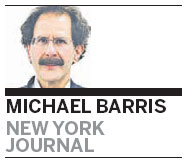NY City bridge repairs can't span US-China steel divide
Updated: 2013-05-16 10:57
By Michael Barris (China Daily)
|
||||||||

Next to seeing the starting point of the New York City Marathon, the best reason to drive across the Verrazano-Narrows Bridge is the panoramic view of New York Harbor. The Statue of Liberty, the dense Manhattan skyline and the grandeur of one of the world's great ports are revealed from the heights of the double-deck suspension bridge linking the boroughs of Staten Island and Brooklyn.
But a half-century of wear and tear has necessitated its replacement.
Last year, the bridge operator, the Metropolitan Transportation Authority, awarded California-based Tutor Perini Corp a five-year, $235.7 million contract to replace the concrete upper roadway with a lighter steel deck.
As its steel fabricator, Perini chose Hebei province-based China Railway Shanhaiguan Bridge Group. China Railway subsequently hired China's Angang Steel Group, or Ansteel, to provide it with nearly 15,000 metric tons of steel plate for fabrication, according to Steel Orbis.com, a website that covers the global steel marketplace.
Amid allegations by the United States that China is dumping low-priced steel on the market to undercut American producers, Ansteel's participation in the revitalization of a New York City landmark comes at a time of bullish promise in the Chinese steel industry - and a challenging period for US producers.
China is the world's leading steel producer. Although its share of world production dipped from 50 percent to 49 percent between February and March, it still accounted for nearly half of the monthly total, according to the US Commerce Department.
In contrast, the US ranked fourth in production, at 5 percent. China's share of global output is bigger than the combined production of the US, the European Union, Russia and Japan, which historically were the top producers of steel.
"Last year the steel industry was difficult worldwide," analyst Jeffrey Friedland wrote on the investment website Seeking Alpha. "China wasn't spared, but even with 2012 being a challenging year for the steel industry in China, the demand for steel in China increased 3.1 percent over 2011.
"China will be the engine of the world's global economic growth for at least the rest of the decade," he wrote, adding his outlook for Chinese steelmakers is positive. US demand for steel is projected to be dampened by the "low economic growth rate", even though demand should grow faster than its economy, due to increased construction activity and auto production, Friedland added.
In March, US steel companies urged Congress and President Barack Obama's administration to take action against what they say has been a flood of unfairly traded steel from China. The request came shortly before the Commerce Department's International Trade Commission approved steep duties on stainless-steel sinks from China that officials had determined were unfairly priced and subsidized.
China's Ministry of Commerce, meanwhile, has launched anti-dumping probes into some alloy-steel seamless pipes imported from the US.
SteelOrbis.com reported that Ansteel has already delivered 10,000 tons of steel plate to China Railway for the Verrazano-Narrows Bridge renovation. Thomas Gibson, president and CEO of the American Iron and Steel Institute, a trade association representing North American producers, criticized the decision to allow Chinese steel's inclusion in the project.
"The taxpayers of New York, and the many American tourists who cross the Verrazano Bridge, should not be forced to have their toll dollars go toward improving the economy of China when American manufacturing needs their support," Gibson said.
"North American-made steel is better-quality, high-performance and continuously being improved to meet new market demand," he said. "State and local governments should only be using fees raised from its residents to purchase US materials in public infrastructure, and not to boost the Chinese steel industry, which is already subsidized by its own government."
A spokeswoman for the Metropolitan Transportation Authority said a Chinese company is allowed to work on the bridge renovation mainly because the MTA is funding the entire project, through bond sales, based on its ability to collect tolls on the New York bridges and tunnels it operates.
Projects that use any federal funding fall under the rules of the Buy American Act, which mandates the purchase of US-made iron, steel and manufactured goods whenever possible.
"There are no restrictions on this project," a spokesman for general contractor Tutor Perini told China Daily.
Contact the writer at michaelbarris@chinadailyusa.com

 Michelle lays roses at site along Berlin Wall
Michelle lays roses at site along Berlin Wall
 Historic space lecture in Tiangong-1 commences
Historic space lecture in Tiangong-1 commences
 'Sopranos' Star James Gandolfini dead at 51
'Sopranos' Star James Gandolfini dead at 51
 UN: Number of refugees hits 18-year high
UN: Number of refugees hits 18-year high
 Slide: Jet exercises from aircraft carrier
Slide: Jet exercises from aircraft carrier
 Talks establish fishery hotline
Talks establish fishery hotline
 Foreign buyers eye Chinese drones
Foreign buyers eye Chinese drones
 UN chief hails China's peacekeepers
UN chief hails China's peacekeepers
Most Viewed
Editor's Picks

|

|

|

|

|

|
Today's Top News
Shenzhou X astronaut gives lecture today
US told to reassess duties on Chinese paper
Chinese seek greater share of satellite market
Russia rejects Obama's nuke cut proposal
US immigration bill sees Senate breakthrough
Brazilian cities revoke fare hikes
Moody's warns on China's local govt debt
Air quality in major cities drops in May
US Weekly

|

|








